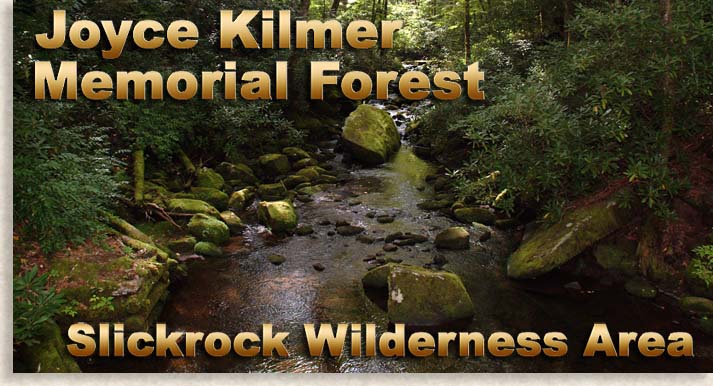
Joyce Kilmer Memorial Forest and Slickrock Wilderness Area
A tree whose hungry mouth is prest
Against the earth’s sweet flowing breast;
Joyce Kilmer
Located just 15 miles from Robbinsville, in Graham County North Carolina, tucked away deep in the Nantahala National Forest and partly in eastern Tennessee, is a rare living national treasure. An ancient, old growth forest of giant trees, untouched by the logging saw. A sanctuary protected and preserved under the Wilderness Act for the enjoyment and the posterity of a people and a great nation.
Of the present 17,013-acres of the Slickrock Wilderness Area, 3,840-acres have been dedicated as a memorial forest in honor of the American poet and patriot of World War 1, Joyce Kilmer, whom penned the infamous nature poem, “Trees.”
 So protected are the mammoth trees of Joyce Kilmer Memorial Forest, that no motorized vehicle or power driven equipment are allowed within the memorial forest. If a tree falls and blocks a trail, the forest service is required to use hand powered logging saws to clear the trail, no chain saws are allowed to disturb this sanctuary.
So protected are the mammoth trees of Joyce Kilmer Memorial Forest, that no motorized vehicle or power driven equipment are allowed within the memorial forest. If a tree falls and blocks a trail, the forest service is required to use hand powered logging saws to clear the trail, no chain saws are allowed to disturb this sanctuary.
There is no camping allowed in the memorial forest or parking area, and overnight parking is prohibited. Also, mountain and other bikes are not allowed in the memorial forest.
There are forest service campgrounds just outside the entrance to the memorial forest, the Horse Cove Campground Area and the Rattler Ford Group Campground. Fishing is also very popular along the Little Santeetlah Creek.
A paved road leads right into the parking area of the memorial forest for the convenience of visitors (direction to memorial forest are located at end of this Highlander featured article.) The parking area provides picnic tables, grills, restrooms, running water, an information kiosk and hiking trail markers.
To reach the actual memorial forest site, you must take the Joyce Kilmer Memorial Trail. The trail is a double looped trail that leads from the parking area to the memorial site in the Poplar Cove. The lower loop is 1.25-miles long and the upper loop is .75 of a mile, making the entire memorial trail 2-miles.
Halfway up the lower loop trail is the Joyce Kilmer Memorial Site, this lower loop also circles a part of the Little Santeetlah Creek, before it returns to the parking area. From the location of the actual memorial site, the upper loop begins its 3/4-mile trail, taking visitors to the largest trees in the memorial forest’s Poplar Cove.
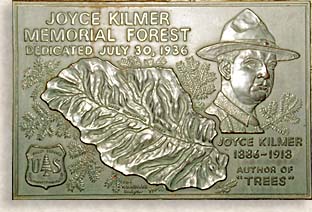 The quickest route to the giant trees is to cross the bridge at the upper end of the parking area. It is time well spent to check the info at the kiosk before crossing the bridge for greater insight into your hiking tour. Just next to the kiosk, you’ll find a polished metal dedication plaque depicting Joyce Kilmer in his World War I military uniform, dedicated July 30, 1936.
The quickest route to the giant trees is to cross the bridge at the upper end of the parking area. It is time well spent to check the info at the kiosk before crossing the bridge for greater insight into your hiking tour. Just next to the kiosk, you’ll find a polished metal dedication plaque depicting Joyce Kilmer in his World War I military uniform, dedicated July 30, 1936.
Although this polished plaque honors Joyce Kilmer and the memorial forest, the official Joyce Kilmer Memorial is at the upper end of the lower loop trail in a the heart of the giant tree stand.
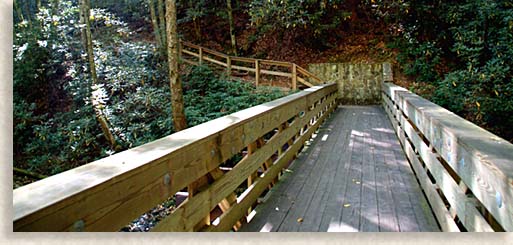
Enter the Forest
The trailhead bridge crosses the Little Santeetlah Creek; the creek more or less divides the memorial forest. As you cross the bridge, look to the right and just up the creek a bit; you’ll notice a large boulder in the middle of the creek. This particular setting of rocks, creek, and forest might be recognizable to you; it has been photographed and used to represent Joyce Kilmer Memorial Forest many times. It is one of the two most popular photo opportunities in the forest, along with the forest of giant trees themselves.
After crossing the Little Santeetlah Creek, you begin the 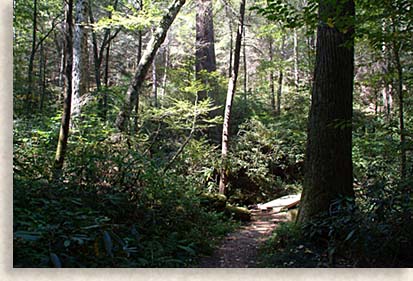 Joyce Kilmer Memorial Trail also known as the Joyce Kilmer National Recreational Trail. The trail gradually works its way up to a more level terrain within a large cove. Along the way you’ll start to come into contact with a few of the larger trees both standing and fallen, keep in mind the largest trees are located along the upper loop trail. Your early experience on the trail will remind you of that old phrase, “you can’t see the forest for the trees,” but that changes once you get into the heart of the memorial forest.
Joyce Kilmer Memorial Trail also known as the Joyce Kilmer National Recreational Trail. The trail gradually works its way up to a more level terrain within a large cove. Along the way you’ll start to come into contact with a few of the larger trees both standing and fallen, keep in mind the largest trees are located along the upper loop trail. Your early experience on the trail will remind you of that old phrase, “you can’t see the forest for the trees,” but that changes once you get into the heart of the memorial forest.
The sometimes-rocky trail is actually part of the watershed runoff with small streams pouring off excess spring water coming down the mountain joining the Little Santeetlah Creek below. The Joyce Kilmer Trail has several small to medium size wooden trail bridges over the larger streams.
Less than half way up the lower loop encounter a small clearing with a large boulder next to one of the giant trees. Displayed on the large boulder is an aged bronze memorial plaque with an inscription dedicated to Joyce Kilmer that reads.
JOYCE KILMER
MEMORIAL FOREST
DEDICATED JULY 30, 1936
JOYCE KILMER 165TH INFANTRY. RAINBOW
DIVISION. SOLDIER AND POET.
AUTHOR OF ‘TREES.’ BORN IN
NEW BRUNSWICK. N.J. DECEMBER
6, 1886:
KILLED IN ACTION IN
FRANCE JULY 30, 1918.
THIS MEMORIAL WAS INITIATED
BY BOZEMAN BULGER POST.
VETERANS OF FOREIGN WARS
AND WAS SELECTED BY THE
U. S. FOREST SERVICE.
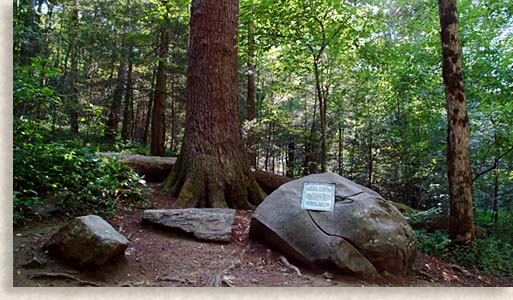 This memorial plaque honoring Joyce Kilmer, will forever link his inspired creativity and bravery with the giants of the North American old growth forests. The down side to this memorial forest and dedication plaque is that Joyce Kilmer never saw these living giants due to his early death.
This memorial plaque honoring Joyce Kilmer, will forever link his inspired creativity and bravery with the giants of the North American old growth forests. The down side to this memorial forest and dedication plaque is that Joyce Kilmer never saw these living giants due to his early death.
Once you’ve reached this point, you must travel onto the upper loop, it's well worth the hike and the reason woodland admirers come to this isolated location.
This part of the trail has a fairly level terrain, (considering we’re in the mountains) which plays a large part as to why these trees have survived so long and grown so large. The more level terrain offers more balance for their enormous size.
From the memorial site the upper loop of the Joyce Kilmer Memorial Trial begins traveling its 3/4 of a mile trail along a path of trees that are over 400 years old. Many of the giant trees you will witness here were young saplings in the days of Hernando DeSoto’s exploration of the North Carolina Mountains and the southerners regions of North America in the 1550’s. He and his companion conquistadors were on a quest for the riches of gold in a yet undiscovered new world.
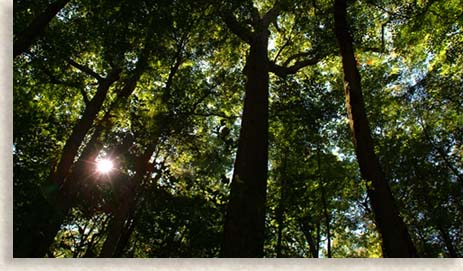
Along the upper loop trail you’re likely to sense a peaceful eeriness deep in the forest. Within this dark forest, rays of sunlight struggle to penetrate the thick green canopy. Ancient fallen forest timbers litter the floor of the cove gracing the ground with their presence, returning by natural process of decay life giving nourishment to these standing giants of the forest.
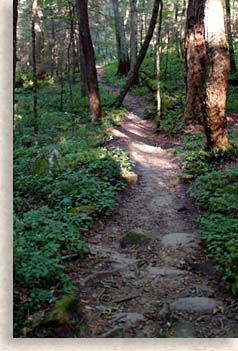 |
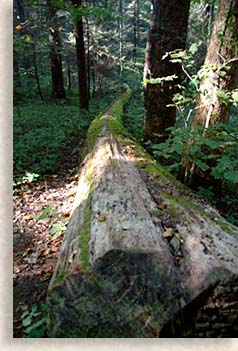 |
Some of the fallen giant trees are so long and have been downed for so long they seem to mimic the trail that skirts alongside their eternal resting place. Tulip-Poplars are the largest trees still remaining in this forest. The Poplars are joined by Hemlocks, Sycamores, Basswoods, Dogwoods, Beeches, Red Oaks, Yellow Birches, and Carolina Silverbells, along with an assortment of other Oak trees.
Many of the giants of this forest are over 400-years old reaching over 100-feet tall and 20-feet in circumference, making this visit into the mountain interior “awe inspiring to say the least."
Remnants of the mighty chestnut trees lie along the floor of the memorial forest stretched out as far as the eye can see, decaying headstones honoring their once stately grandeur.
The Chestnut trees were the greatest of the tree giants in the eastern forest. Unfortunately, the Chestnut trees accidentally came in contact with a disease that originated in Asia. This disease found its way to the North American Continent through imports around the turn of the 20th century. Over several decades, the disease that was said to have started in New York destroyed all the mature Chestnut trees that graced the Appalachian Mountains.
So grand were these giant Chestnuts, that their nuts provided nourishment in abundance to mountain wildlife. Their white blossoms and the sheer numbers of these mammoth trees made the mountaintops look snow capped on warm spring days. All that is left of their memory is decaying tree trunks and small chestnut saplings that never reach maturity due to the ongoing Chestnut tree blight.
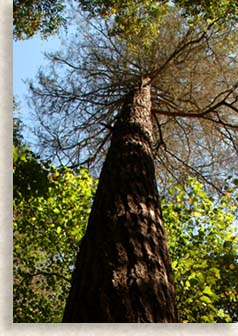 Even today the Hemlock trees of all sizes, accidentally came in contact with an aphid-type insect from the Orient and like the Chestnut trees are dying off, as well as many second growth Pine trees throughout the Appalachian Mountains due to infestations of Pine Beetles.
Even today the Hemlock trees of all sizes, accidentally came in contact with an aphid-type insect from the Orient and like the Chestnut trees are dying off, as well as many second growth Pine trees throughout the Appalachian Mountains due to infestations of Pine Beetles.
What remains of these ancient trees need to be fully protected from outside influence, to be left in their natural state of progression. When it comes to designated wilderness areas, it is a policy of the U.S. Forest Service that they must remain in their natural state and environment.
Also it is important to be aware of impending danger when in the memorial forest, with 400-year old trees standing around that are not getting any younger. There are other health issues with some of these giants while others still are slowly dying of natural causes, making their heavy limbs brittle. During heavy rains, winds, even snow or ice, these limbs can fall, it’s best advised to avoid a stroll through any forest, old or second growth during bad weather conditions. Some have even fallen on clear weather days due to the natural pull of gravity. In as many visits that Mrs. Highlander and I have made to this memorial forest, we have yet to see any branches falling, beware just the same when standing up close to the older trees.
Supporting this graveyard of fallen trees and branches is the understory, a soft layer of bright green moss, lichens, fungi wildflowers and decaying wood all giving much needed nourishment and beauty to this old growth forest. The understory of an ancient forest is different from the second growth forest, which are lush and heavy with thick underbrush. An old growth forest is relatively more open at ground level and deprived of sunlight due to the large shading trees.
Amongst the wildflowers that grow in the Joyce Kilmer Memorial Forest, you’ll find Violets, Trillium, Galax, Jack-in-the-Pulpit, Crested Dwarf Iris, Solomon’s Seal, and Ubiquitous Ferns. Keep in mind, this is a highly protected forest, and it is forbidden to take any plants alive or dead out of the forest. Do bring a camera though and take all the shots you want.
When it comes to wildlife, the forest is filled with the songs of many different types of songbirds that make Joyce Kilmer Memorial Forest their home. Though their songs are often faint, filtered by the great heights of the tree limbs above, bird enthusiast can recognize the songs of Wood Thrushes, Golden-Crowned Kinglets, Ovenbirds, Scarlet Tanagers, Brown Creepers, Downy Woodpeckers, Solitary and Red-eyed Vireos, all have been spotted in the memorial forest.
The larger wildlife in this forest are bears, wild boars, deer, red fox, squirrels, chipmunks along with most other mountain wildlife. Due to the number of visitors to the Joyce Kilmer Memorial Forest, these critters mostly avoid the popular trail areas, yet their presence is there all the same.
During hunting season, especially the autumn season you can run into licensed hunters using the Joyce Kilmer Memorial Trail to access other trails in the Slickrock Wilderness Area region. That, along with many other reasons makes it better not to go wandering off the trails.
The Joyce Kilmer Memorial Forest and Slickrock Wilderness Area have over 60-miles of trails. The majority of the trails are rugged and unmarked; it takes an experienced hiker with a topographic map and compass to traverse the most remote high ground in this wilderness.
By far the most popular trail in the memorial forest is the Joyce Kilmer Memorial Trail. Other well-used and accessible trails in the memorial forest area are the Naked Ground Trail, Jenkins Meadow Trail, and the Stratton Bald Trail.
Popular trails in the Slickrock Wilderness Area outside of the memorial forest are Big Fat Gap Trail, Falls Branch Falls Trail, Hanover Lead Trail, Slickrock Creek Trail, and Stiffknee Trail.
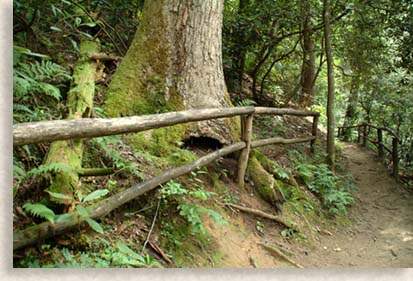 The Joyce Kilmer Memorial Trail is well mark and heavily worn since it opened to the public in 1936. One summer afternoon Mrs. Highlander and I were on the upper end of the loop when a dark cloud mass covered the area, it quickly began getting dark. Our first concern was getting out of the storm to protect our photo equipment, we didn’t even think about the old tree limbs. As we marched on along the upper loop of the trail, it kept getting darker and darker and our concern turned towards the lack of trail light rather than the equipment. It became so dark that if it weren’t for the trail being so worn and easy to follow, we would have needed a flashlight to find our way back to the parking area and it was only about 4 o’clock on a summer afternoon.
The Joyce Kilmer Memorial Trail is well mark and heavily worn since it opened to the public in 1936. One summer afternoon Mrs. Highlander and I were on the upper end of the loop when a dark cloud mass covered the area, it quickly began getting dark. Our first concern was getting out of the storm to protect our photo equipment, we didn’t even think about the old tree limbs. As we marched on along the upper loop of the trail, it kept getting darker and darker and our concern turned towards the lack of trail light rather than the equipment. It became so dark that if it weren’t for the trail being so worn and easy to follow, we would have needed a flashlight to find our way back to the parking area and it was only about 4 o’clock on a summer afternoon.
We arrived back at the parking lot without a drop of rain hitting us. Once our vehicle reached the entrance to the memorial forest, the asphalt on the highway was rain soaked black and steaming from the sunrays piercing the tree cover. Between our prayers and the forest covering, all was well.
Beautiful, Mysterious and Awe Inspiring
A tree that looks at God all day
And lifts her leafy arms to pray;
Joyce Kilmer
Each time we visit Joyce Kilmer Memorial Forest, the atmosphere has always been beautiful, mysterious and inspiring. Mere words fail to express the majesty of these Giants of the Forest, we give thanks to the creator for this truly unique blessing.
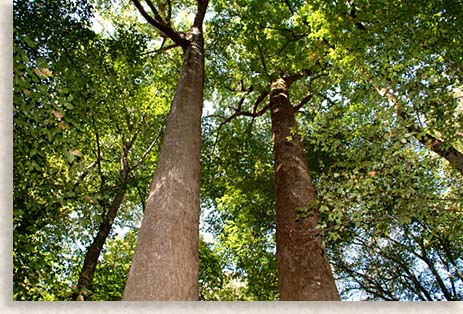 Deep within this hidden forest are columns of giant trees shooting skyward, creating a mythical mountain cathedral with giant branches that reach across the sky. Covered throughout the year under the cathedral ceiling of the forest are flowering tree buds, sprouting leaves and wildflowers welcoming the spring-time back to life. In the summer months a thick green and often translucent canopy of leaves mimic the atmosphere of an ancient rainforest. Colored leaves display their autumn beauty throughout the forest, glorifying its own natural state of elegance. The rooftop of this forest cathedral opens to the heavens during the winter months, exposing its sheer innocent nature at the season’s end. The floor of the mountain cathedral forest rotates each growing season with an array of wildflowers and mountain laurel.
Deep within this hidden forest are columns of giant trees shooting skyward, creating a mythical mountain cathedral with giant branches that reach across the sky. Covered throughout the year under the cathedral ceiling of the forest are flowering tree buds, sprouting leaves and wildflowers welcoming the spring-time back to life. In the summer months a thick green and often translucent canopy of leaves mimic the atmosphere of an ancient rainforest. Colored leaves display their autumn beauty throughout the forest, glorifying its own natural state of elegance. The rooftop of this forest cathedral opens to the heavens during the winter months, exposing its sheer innocent nature at the season’s end. The floor of the mountain cathedral forest rotates each growing season with an array of wildflowers and mountain laurel.
We can feel free to revere the raw nature of 400 years of the life giving properties that emanate from these giants of the forest. To recognize the grandeur of nature’s finest work, an appreciation well served in our human consciousness.
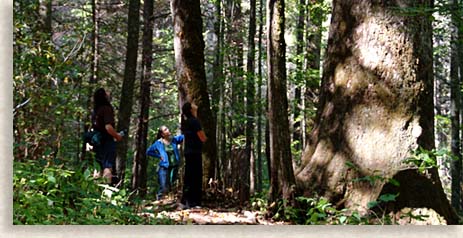 Within these giant trees, lives both a rich an enduring past as well as a prosperous, symbolic present, maintaining a natural organic life that outlives us all. We are moderately small in the scheme of life compared to these ancient trees; they provide mankind with a wealth we humans cannot duplicate.
Within these giant trees, lives both a rich an enduring past as well as a prosperous, symbolic present, maintaining a natural organic life that outlives us all. We are moderately small in the scheme of life compared to these ancient trees; they provide mankind with a wealth we humans cannot duplicate.
Thanks to the U.S. Forest Service we can offer these Giants of the Forest a little protected space deep in the wilderness, giving respect to their worldly contribution as our nation's own personal “icons of the forest.”
Who among us is fitting to explain what is unexplainable, to describe the essence of something within nature we didn’t have any part in creating? Seeking to identify the mystery of its very nature, through his delicate words, Joyce Kilmer touched our inner being with his truth, sacrifice and sincerity.
TREES I think that I shall never see A tree whose hungry mouth is prest A tree that looks at God all day A tree that may in summer wear Upon whose bosom snow has lain; Poems are made by fools like me, Joyce Kilmer, 1913 |
The presence of these giant trees is so large within the confinement of their woodland space that most cameras can’t frame big enough to tell their story and the lighting is often a challenge when trying to capture the true nature of this forest. So when the time comes that you get the chance to stand amongst these giants, capture them in your memory hold them in your heart, it will make you ever the more wiser.
When you consider that the U.S. Forest Service paid and outrageous price of 7 times the average price for local land in 1936, I think the U.S. Forest Service and the people of our nation got quite a bargain in this unique, one of a kind national treasure.
Direction to Joyce Kilmer Memorial Forest and Slickrock Wilderness Area
The Joyce Kilmer Memorial Forest Slickrock Wilderness Area is located in the Nantahala National Forest in far western North Carolina with parts in the Cherokee National Forest in eastern Tennessee. Two towns access the memorial forest wilderness, Robbinsville and Tellico Plains.
From Robbinsville in Graham County, North Carolina take NC 143 west for 12-miles turning right onto Joyce Kilmer Road. Travel 2-miles and turn left on the paved forestry road, the parking area is 1/4 –mile ahead.
From Tellico Plains in Monroe County, Tennessee take TN 165 east over the Cherohala Skyway for approximately 50-miles; the drive over the Unicoi Crest is well worth the miles. At the end of the Cherohala Skyway turn left onto Joyce Kilmer Road. Go 2-miles and turn left onto the paved forestry road; the parking area is a 1/4 –mile ahead.
Have a safe trip...the Highlander..
Visit Joyce Kilmer Memorial Forest • Joyce Kilmer - Patriot Poet
History of Joyce Kilmer Memorial Forest • Nearby Points of Interest
![]()
Sign
up for the Blue Ridge Highlander Newsletter, Messages from the Mountains
to find out first about our new feature stories, road trips and special offers
Your e-mail addresses will not be sold or given away to anyone.
Privacy
Policy
Interested in your business being on the Highlander, click here...
Let our visitors tell you about the Highlander...
Click the feathers to go to the Highlander site
map...

